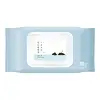What's inside
What's inside
 Key Ingredients
Key Ingredients

 Benefits
Benefits

 Concerns
Concerns

No concerns
 Ingredients Side-by-side
Ingredients Side-by-side

Water
Skin ConditioningMethylpropanediol
SolventDipropylene Glycol
HumectantPolyglyceryl-6 Caprylate
EmulsifyingSea Water
HumectantSodium Hyaluronate
HumectantSodium Acetylated Hyaluronate
HumectantHydrolyzed Hyaluronic Acid
HumectantAllantoin
Skin ConditioningDipotassium Glycyrrhizate
HumectantPanthenol
Skin ConditioningMaltodextrin
AbsorbentSodium Metabisulfite
AntioxidantProtease
ExfoliatingPolyglyceryl-4 Caprate
EmulsifyingSodium Citrate
BufferingHydroxyacetophenone
AntioxidantDecylene Glycol
Skin ConditioningLaurylpyridinium Chloride
AntimicrobialLevulinic Acid
PerfumingSodium Levulinate
Skin ConditioningDisodium EDTA
1,2-Hexanediol
Skin ConditioningCitric Acid
BufferingWater, Methylpropanediol, Dipropylene Glycol, Polyglyceryl-6 Caprylate, Sea Water, Sodium Hyaluronate, Sodium Acetylated Hyaluronate, Hydrolyzed Hyaluronic Acid, Allantoin, Dipotassium Glycyrrhizate, Panthenol, Maltodextrin, Sodium Metabisulfite, Protease, Polyglyceryl-4 Caprate, Sodium Citrate, Hydroxyacetophenone, Decylene Glycol, Laurylpyridinium Chloride, Levulinic Acid, Sodium Levulinate, Disodium EDTA, 1,2-Hexanediol, Citric Acid
Water
Skin ConditioningGlycerin
HumectantSodium Cocoyl Alaninate
Lauryl Hydroxysultaine
CleansingDisodium Cocoamphodiacetate
CleansingSodium Methyl Cocoyl Taurate
CleansingAcrylates/C10-30 Alkyl Acrylate Crosspolymer
Emulsion StabilisingBetula Platyphylla Japonica Juice
Skin ConditioningButylene Glycol
HumectantSodium Hyaluronate
HumectantHyaluronic Acid
HumectantSodium Chloride
MaskingGlyceryl Glucoside
HumectantAscorbic Acid
Antioxidant1,2-Hexanediol
Skin ConditioningArtemisia Annua Extract
MaskingChamomilla Recutita Flower Oil
MaskingPinus Sylvestris Leaf Oil
MaskingQuillaja Saponaria Bark Extract
CleansingCaprylyl Glycol
EmollientCoco-Glucoside
CleansingGlyceryl Caprylate
EmollientSodium Cocoyl Isethionate
CleansingHexylene Glycol
EmulsifyingCitric Acid
BufferingDisodium EDTA
Water, Glycerin, Sodium Cocoyl Alaninate, Lauryl Hydroxysultaine, Disodium Cocoamphodiacetate, Sodium Methyl Cocoyl Taurate, Acrylates/C10-30 Alkyl Acrylate Crosspolymer, Betula Platyphylla Japonica Juice, Butylene Glycol, Sodium Hyaluronate, Hyaluronic Acid, Sodium Chloride, Glyceryl Glucoside, Ascorbic Acid, 1,2-Hexanediol, Artemisia Annua Extract, Chamomilla Recutita Flower Oil, Pinus Sylvestris Leaf Oil, Quillaja Saponaria Bark Extract, Caprylyl Glycol, Coco-Glucoside, Glyceryl Caprylate, Sodium Cocoyl Isethionate, Hexylene Glycol, Citric Acid, Disodium EDTA
Ingredients Explained
These ingredients are found in both products.
Ingredients higher up in an ingredient list are typically present in a larger amount.
1,2-Hexanediol is a synthetic liquid and another multi-functional powerhouse.
It is a:
- Humectant, drawing moisture into the skin
- Emollient, helping to soften skin
- Solvent, dispersing and stabilizing formulas
- Preservative booster, enhancing the antimicrobial activity of other preservatives
Citric Acid is an alpha hydroxy acid (AHA) naturally found in citrus fruits like oranges, lemons, and limes.
Like other AHAs, citric acid can exfoliate skin by breaking down the bonds that hold dead skin cells together. This helps reveal smoother and brighter skin underneath.
However, this exfoliating effect only happens at high concentrations (20%) which can be hard to find in cosmetic products.
Due to this, citric acid is usually included in small amounts as a pH adjuster. This helps keep products slightly more acidic and compatible with skin's natural pH.
In skincare formulas, citric acid can:
While it can provide some skin benefits, research shows lactic acid and glycolic acid are generally more effective and less irritating exfoliants.
Most citric acid used in skincare today is made by fermenting sugars (usually from molasses). This synthetic version is identical to the natural citrus form but easier to stabilize and use in formulations.
Read more about some other popular AHA's here:
Learn more about Citric AcidDisodium EDTA plays a role in making products more stable by aiding other preservatives.
It is a chelating agent, meaning it neutralizes metal ions that may be found in a product.
Disodium EDTA is a salt of edetic acid and is found to be safe in cosmetic ingredients.
Learn more about Disodium EDTASodium Hyaluronate is hyaluronic acid's salt form. It is commonly derived from the sodium salt of hyaluronic acid.
Like hyaluronic acid, it is great at holding water and acts as a humectant. This makes it a great skin hydrating ingredient.
Sodium Hyaluronate is naturally occurring in our bodies and is mostly found in eye fluid and joints.
These are some other common types of Hyaluronic Acid:
Learn more about Sodium HyaluronateWater. It's the most common cosmetic ingredient of all. You'll usually see it at the top of ingredient lists, meaning that it makes up the largest part of the product.
So why is it so popular? Water most often acts as a solvent - this means that it helps dissolve other ingredients into the formulation.
You'll also recognize water as that liquid we all need to stay alive. If you see this, drink a glass of water. Stay hydrated!
Learn more about Water